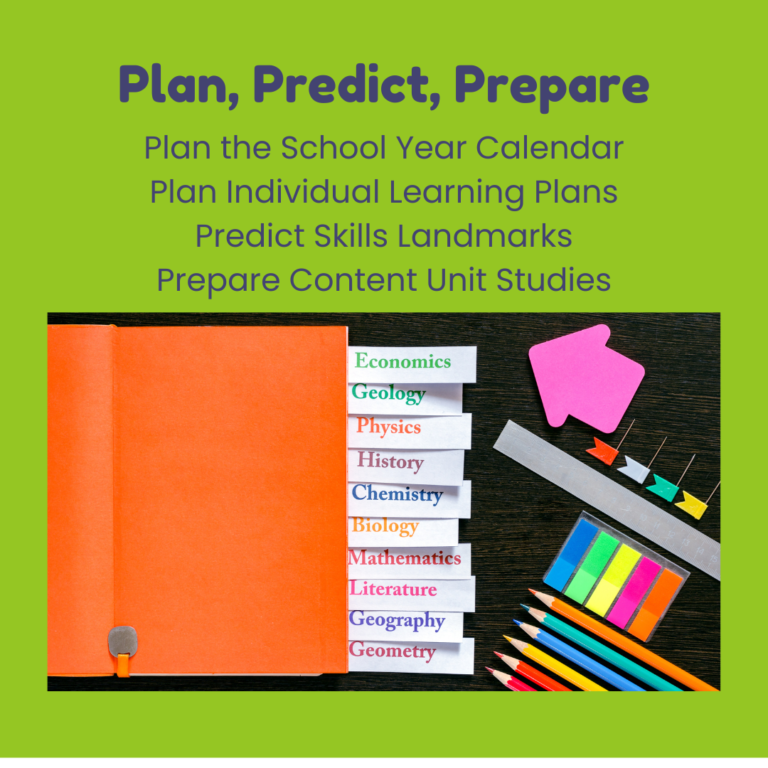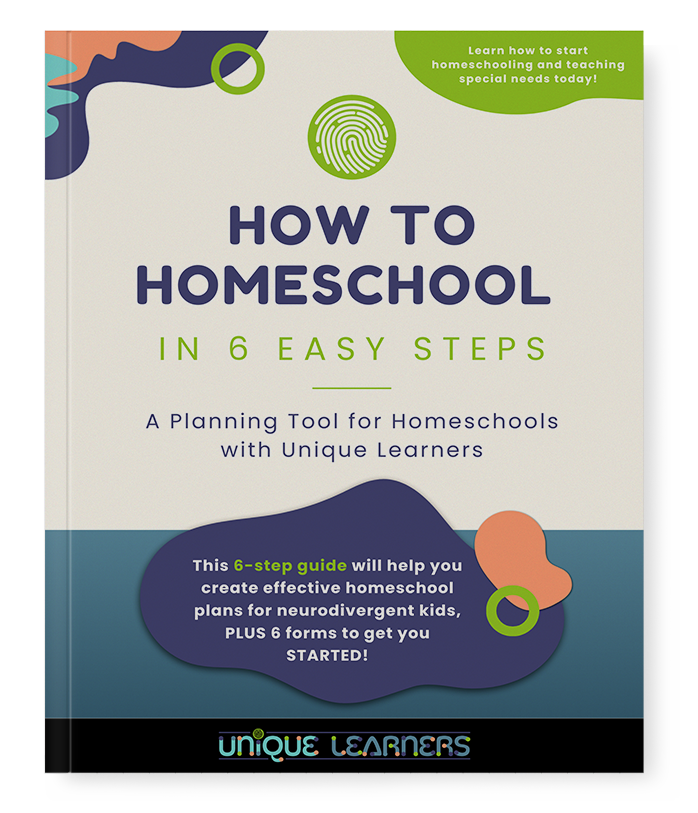Many new homeschoolers ask how to get started on planning their homeschool year. They are eager to order homeschool curriculum. A few months into the school year, moms say they are overwhelmed and feel like school takes all day. Other moms try to do a relaxed approach but report that they feel “behind” and are worried they are not doing enough. Homeschool planning can definitely be overwhelming.
So, how do you find a balance while planning your homeschool year?
How do you finish everything you wanted to accomplish in a school year and still keep your sanity from trying to keep up with school, housework, social activities, extra lessons, sports, work, and of course, the never-ending laundry.
If you’ve ever been to a homeschool convention exhibit hall or searched for homeschool curriculum online, you already know there are so many choices for approaches and for curriculum. In a similar way, if you search how to plan a homeschool year, you will find many different methods for preparing. No wonder new homeschoolers are overwhelmed! Then add in the challenges of homeschooling a child with special needs, and the options become confusing because we want the marvelous experience that seasoned homeschoolers report, yet the homeschool curriculum and methods often mismatch with our unique learners. And how to you plan for a kid who makes inconsistent progress?

One approach to planning is to follow the lesson plans of your curriculum. But any curriculum-driven approach can feel overwhelming and not fit the pace your children need to reach mastery.
Other systems suggest planning week-by-week. That is what I did as a classroom teacher. But in homeschool, I was always rolling forward what we didn’t cover because my kids wanted to learn something different, and I wanted to nurture their naturaly curiosity. Then I wanted to throw out my homeschool year plan because it became a mess and I lost sight of where we were headed to reach our ultimate goals.
Over the years, I came up with a system between curriculum-driven and going with the flow. It worked for us, and I hope you will find a balance in the way I did my yearly and weekly planning.
Planning a homeschool year can be an exciting and rewarding process. Here are some steps to help you get started:
1. Set goals for your homeschool year.
Begin by identifying your educational goals for the year. Consider your child’s strengths, weaknesses, and interests. What specific skills or knowledge do you want them to acquire?
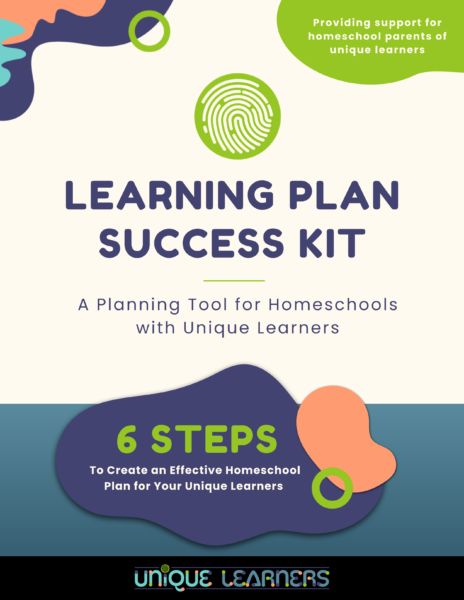
Unique Learners has a FREE Learning Plan Success Kit that walks you through how to select your approach and how to look at your child’s learning profile. We also have a video course that unpacks each of the six steps in the success kit for more thorough planning of your homeschool structure.
2. Choose a homeschool curriculum.
Research and select a homeschool curriculum that aligns with your goals. Look for materials that suit your child’s learning needs. You can download a free planning form for all subjects required by most states, and even more! If you need assistance, consider joining our membership this fall.
3. Plan out your days of the school year.
Use a small calendar to look at holidays, birthdays, and other special times when you want to take breaks. Will you do a 4-day week or a 5-day week? Cross out any days you for sure will not do school. Any of the rest are likely to be school days. Count to be sure your number of days fills the requirement for your state law. Our state required minutes, so I took the minutes and divided by 6 hours find the number of days. (1080 required hours ÷ 6 regular school hours = 180 school days). We preferred to do shorter school days all year and take more frequent breaks than a long summer. Somehow my plan always came to nearly 200 days!
4. Get a planner that works for you.
I usually created my own lesson planner so it was tailored to the way I planned individual lessons and whole family activities. Unique Learners is launching our first homeschool planner! If you want to be notified when the new Homeschool Yearly Planner is released, be sure to sign up for our email newsletter. We plan to make this new planner FREE for our members!
5. THEN order your homeschool curriculum.
I would order the basic core curriculum we needed for the first semester or the whole year if possible. I would look for used materials locally or on sites, like Facebook Marketplace, Ebay, Amazon, Homeschool Classifieds, Mercari, and OfferUp. I went to garage sales that announced homeschool or teacher curriculum. I went to used homeschool book sales.
Once I searched for used items, if I was at a homeschool convention or curriculum fair, I would buy any new materials at special convention discounts. If I wasn’t sure, I would just keep watching online sources so that I almost never full price for new curriculum.
Be aware that downloadable, printable curriculum is very popular right now. The cost can be very high as you include the price of the program, a decent printer, ink, paper, assembly time, and more. And digital products are often not able to be resold. Reselling teacher manuals or student textbooks can be one way to recuperate costs to use for the next year. You may find that digital products are well worth the flexibility but be sure to do the math if you are trying to keep costs down.
6. Start by planning skills subjects for your homeschool year.
To plan out the year, I planned out the skills subjects first. I always kept the reading, phonics/spelling, grammar, handwriting, and math as individual lessons with me. I had space for each child in these subjects. I knew my kids would work to mastery in these subjects, so I did not fill in each space. I also filled in the planner with pencil, so that concepts and skills could be erased as needed. I filled out major skills areas on Monday. That way I had a broad idea where we might be in each area, knowing that each kiddo may take a faster or a slower pace than I anticipated. For my kids who were more inconsistent in retaining information, I just did the first week and planned skills weekly.
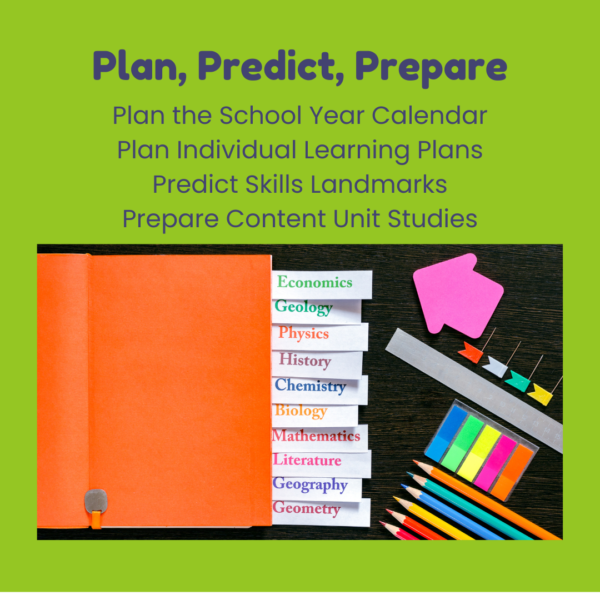
7. Plan whole family lessons.
Break down the homeschool curriculum into manageable units or lessons. Most textbooks are divided into Units, Chapters, and Lessons. Often, there are 9 or 18 Units in a text, meant to be covered in a month or every 2 weeks. Chapters represent the weeks in a school year. You will typically count 36 to 40 Chapters. Lessons represent what is expected to be covered daily. If you are following a textbook approach, you also need to plan in test and project or experiment days.
We used textbooks as a “spine” for our unit studies. A spine is a resource for topics and background information. When the children are younger, I used our spine for my own information to tell my children in a storytelling presentation. As they got older, we would share the spine as one of the many references for research. I would start planning unit studies by making a list of topics for social studies, science, Bible, and any other content area we wanted to study.
Once I made a list of the topics, I would list out the months with tick marks for each week in the months. Then I started assigning a unit study topic to each week. Some of our units were longer, taking two weeks to the whole month. Most of the time, one week was adequate to explore as deep as we wanted.
Then I started filling in the homeschool planner with the unit topics. I did not fill in specific activities because it gave me flexibility to do my homeschool planning shortly before each unit study.
8. You can order as you go.
I usually looked about a month ahead to that if we needed specific materials, art supplies, videos, or other resources, I could order them in time. Ordering by the month helped to spread out the expenses. When supplies arrived, the kids would get excited again and again, so they could always look forward to opening boxes of new books and fun things.
I love looking for ideas on Pinterest and in my homeschool mom groups! Many times, I come across an idea I really want to do with my kids. I would feel a lack of response to my kids’ learning preferences if I planned every single day throughout the homeschool year. It was more fun to plan shortly in advance so that I could prepare myself for the information.
9. Track milestones and progress throughout your homeschool year.
For skills, determine how you will assess your child’s progress throughout the year. I would make sure my kids were working to 80% or 90% mastery levels on daily work. I seldom gave classroom types of tests because they were competent with their reading, spelling, grammar, and math skills. Since I created an Individual Learning Plan (ILP) in the skills areas, I would make quarterly evaluations based on Mastery, Improving, Continue, or Not Introduced. That way I could see how they were progressing across larger time frames. The ILP also helped me to adjust my teaching approach according to each child’s needs.
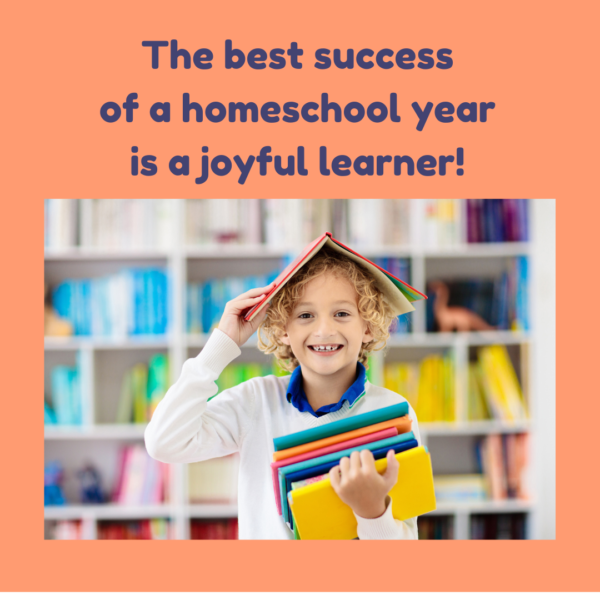
To track progress in the content areas, I just checked off the units in my Homeschool Planner as we did each study. If we changed the sequence to adjust to the kids’ interest or for field trips by our local homeschool group, I was able to just check off rather than rewrite the entire plan. By the end of most years, we had covered all of our unit studies and then some!
10. Keep records, especially if your state requires documentation that you are “doing school.”
The main record I kept for monitoring progress was my Homeschool Planner. The second documentation I kept was the Individual Learning Plan that also served as a report card in the state that required one. You may also keep a homeschool journal of observations about your children and their learning.
A portfolio is just a collection of work samples from your homeschool year or semester.
I usually threw daily work into a box until the end of the semester or year. Then I would sort through the work and kept a few handwriting samples, special artwork, literature reading lists, writing assignments, and a few math examples. I would also keep any notable projects from social studies and science recording notebooks. Every year, I would purge more and more so that when each kid graduated, they have just a few examples of their homeschool journey.
Do any yearly assessments required or needed.
If your state requires yearly standardized testing, Unique Learners may be able to assist with individually administered achievement tests for kids with special needs. Be sure to check the requirements of your state.
If you need assistance with informal placement or progress monitoring, contact us. We can help with finding out what levels your children are performing in reading, writing, spelling, and math. Knowing your child’s academic levels can help you plan better, saving money nad time in the long run!
11. Share ideas and stay connected!
Finding ideas can be fun, yet time consuming. Join local homeschool communities or online forums to connect with other families. Ask questions. Share your own successes. Don’t be afraid to share your struggles also. We all have been there, especially those of us homeschooling kids with special needs.

If you find it difficult to find a group to connect with where the moms are encouraging and understanding of your situation, consider joining the Unique Learners community. You will have professional support whenever you need ideas for curriculum or teaching strategies. We will have weekly Zoom meetings where you can ask questions and learn! You will have compassionate friendships with other moms who feel isolated. And the Unique Learners team can design curriculum that specifically fits your unique learner! The membership will launch this fall, and you are invited to join us!
Remember, homeschooling allows for flexibility and customization. Be open to adapting your plan as you attempt to meet your child’s ever-changing needs and interests throughout your homeschool year.
Happy homeschooling!
Note: Homeschooling laws and regulations vary by jurisdiction. It’s important to familiarize yourself with the legal requirements in your area.
https://aliveandgrowingathome.com/planning-your-homeschool-year/
https://www.hopeinthechaos.com/homeschooling-how-to-get-started-part-5/
